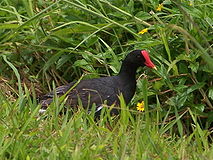- Common Moorhen
-
Common Moorhen 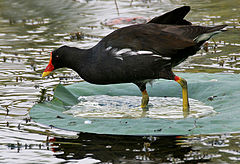
Eurasian Common Moorhen
(Gallinula chloropus chloropus)Conservation status Scientific classification Kingdom: Animalia Phylum: Chordata Class: Aves Subclass: Neornithes Infraclass: Neognathae Superorder: Neoaves Order: Gruiformes Family: Rallidae Genus: Gallinula Species: G. chloropus Binomial name Gallinula chloropus
(Linnaeus, 1758)Subspecies About 12, see text
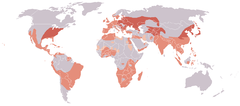
Global range.
Chestnut: Summer only
Coral pink: Year-round
Light pink: Winter only.Synonyms Gallinula brodkorbi McCoy, 1963
Gallinula galeataThe Common Moorhen (Gallinula chloropus) is a bird in the Rallidae family with an almost worldwide distribution. The North and South American Committees of the AOU and the IOC have voted on or before July 2011 to split the American forms into a new species Common Gallinule, however, no other committee has voted to change taxonomy yet. In that light, the American forms can now be found under a separate species listing Common Gallinule,[1] however all forms can still be found here until further actions are taken. It lives around well-vegetated marshes, ponds, canals and other wetlands. The species is not found in the polar regions, or many tropical rainforests. But elsewhere the Common Moorhen is likely the most commonly seen rail species to most people, excepting the Eurasian Coot or American Coot in some regions.
Contents
Name confusion
The name mor-hen has been recorded in English since the 13th century,[2] and the word moor here is an old sense meaning marsh[2] - the species is not usually found in moorland. An older alternative name, Common Waterhen, is a more descriptive because of the bird's habitat.
A "Watercock" is not a male "Waterhen", but the rail species Gallicrex cinerea, not especially closely related to the Common Moorhen. "Water Rail" usually refers to Rallus aquaticus, again not closely related.
The scientific name Gallinula chloropus comes from the Latin Gallinula (a small hen or chicken) and the Greek chloropus (khloros χλωρός green or yellow, pous πούς foot).[3]
Description and ecology
The Moorhen is a distinctive species, with dark plumage apart from the white undertail, yellow legs and a red facial shield. The young are browner and lack the red shield. It has a wide range of gargling calls and will emit loud hisses when threatened.[4]
This is a common breeding bird in marsh environments and well-vegetated lakes. Populations in areas where the waters freeze, such as southern Canada, the northern USA and eastern Europe, will migrate to more temperate climes. This species will consume a wide variety of vegetable material and small aquatic creatures. They forage beside or in the water, sometimes upending in the water to feed. It is often secretive, but can become tame in some areas. Despite loss of habitat in parts of its range, the Common Moorhen remains plentiful and widespread. They fight over territories and also hop around Lily pads.
The nest is a basket built on the ground in dense vegetation. Laying starts in spring, between mid-March and mid-May in N hemisphere temperate regions. About 8 eggs are usually laid per female early in the season; a brood later in the year usually has only 5-8 or even less eggs. Nests may be re-used by different females. Incubation lasts about three weeks. Both parents incubate and feed the young. These fledge after 40–50 days, become independent usually a few weeks thereafter, and may raise their first brood the next spring. When threatened, the young may cling to the parents' body, after which the adult birds fly away to safety, carrying their offspring with them.[5]
Despite being an abundant and widespread species, small populations are more prone to extinction. The Hawaiian Moorhen or ʻalae ʻula (G. c. sandvicensis) is suspected to be threatened by the Small Indian Mongoose (Herpestes javanicus) which was introduced to the Hawaiian Islands to hunt rats but found the local birdlife easier prey. The Mariana Common Moorhen or pulattat (G. c. guami) is very rare nowadays due to destruction of habitat. Only some 300 adult birds remained in 2001, and it is listed as Endangered both federally (since 1984) and locally.[6]
The population of Palau, belonging to the widespread subspecies G. c. orientalis and locally known as debar (a generic term also used for ducks and meaning roughly "waterfowl"), is also very rare, and apparently the birds are hunted by locals. Most of the population on the archipelago occurs on Angaur and Peleliu, while the species is probably already gone from Koror. In the Lake Ngardok wetlands of Babeldaob, a few dozen still occur, but the total number of Common Moorhens on Palau is about in the same region as the Guam population; less than 100 adult birds (usually less than 50) have been encountered in any survey.[7]
On a global scale – all subspecies taken together –, the Common Moorhen is as abundant as its vernacular name implies. It is therefore considered a species of Least Concern by the IUCN.[8]
The Common Moorhen is one of the birds (the other is the Eurasian Coot, Fulica atra) from which the cyclocoelid flatworm parasite Cyclocoelum mutabile was first described.[9] This species is parasitised by the moorhen flea, Dasypsyllus gallinulae.[10]
Subspecies
About one dozen subspecies are today considered valid; several more have been described which are now considered junior synonyms. Most are not very readily recognizable as differences are rather subtle and often clinal. Usually, the location of a sighting is the most reliable indication as to subspecies identification, but the migratory tendencies of this species make identifications based on location not completely reliable. Old World birds have a frontal shield with rounded top and fairly parallel sides; the tailward margin of the red unfeathered area is a smooth waving line. American birds have a frontal shield that has a fairly straight top and is less wide towards the bill, giving a marked indentation to the back margin of the red area.
In addition to the extant subspecies listed below, there are two Pleistocene populations known from fossils; they were distinct (generally larger) birds and probably the direct ancestors of some of today's Common Moorhens: The stout and long-winged paleosubspecies G. c. brodkorbi is known from the Ichetucknee River deposits in Florida; it was originally described as a distinct species. The presence of fossils typical of the shorter-winged and more delicate G. c. cerceris in the same deposits suggests that brodkorbi was not ancestral to the "Florida Gallinule" of our time but rather to the more northernly "Common Gallinule". An undescribed form is recorded from the Early Pleistocene of Dursunlu in Turkey.[11]
List of subspecies by date of description Common and
trinomial namesDescription Range Eurasian Common Moorhen
G. c. chloropus (Linnaeus, 1758)
Includes correiana and indica.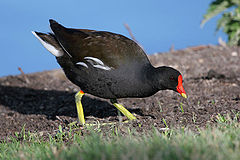
Wings and back blackish-olive Ranges from Northwest Europe to North Africa and eastwards to Central Siberia and from the humid regions of southern Asia to Japan and Central Malaysia; also found in Sri Lanka and the Canary, Azores, Madeira, and Cape Verde islands. Southern American Common Moorhen
G. c. galeata (Lichtenstein, 1818)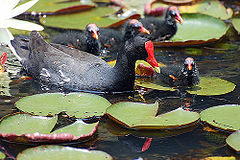
Wings and back are fairly uniform dark brownish slate grey. Found in Trinidad, the Guyanas, and from Brazil south of the Amazonas to North Argentina and Uruguay. Indo-Pacific Common Moorhen
G. c. orientalis (Horsfield, 1821)Small, with slate grey upperwing coverts and large frontal shield. Found in the Seychelles, Andaman Islands, and South Malaysia through Indonesia; also found in the Philippines and Palau. The breeding population existing on Yap in Micronesia since the 1980s is probably of this subspecies, but might be of the rare G. c. guami.[12]
Population size: Perhaps a few 100s on Palau as of the early 2000s,[7] less than 100 on Yap as of the early 2000s.[12]African Common Moorhen
G. c. meridionalis (C. L. Brehm, 1831)Similar to orientalis, but the frontal shield is smaller. Found in Sub-Saharan Africa and Saint Helena. Madagascan Common Moorhen
G. c. pyrrhorrhoa (A. Newton, 1861)Similar to meridionalis, but the undertail coverts are buff. Found on the islands of Madagascar, Réunion, Mauritius, and the Comoros. Andean Common Moorhen
G. c. garmani (Allen, 1876)Similar to galeata, but larger. Found in the Andes from Peru to Northwest Argentina. Hawaiian Moorhen
G. c. sandvicensis (Streets, 1877)
Called ʻalae ʻula ("red Hawaiian Coot") in Hawaiian.Has a large frontal shield; the tarsus is reddish-orange in front. Endemic to the Hawaiian Islands.[13] Antillean Common Moorhen
G. c. cerceris (Bangs, 1910)
The now-obselete name of Florida Gallinule was once used the U.S.[14]
Has a long bill and large feet and is less brown above. Found in the Antilles, except Trinidad and Barbados; also found in South Florida. North American Common Moorhen
G. c. cachinnans (Bangs, 1915)
Also known as Common Gallinule and Marsh Hen.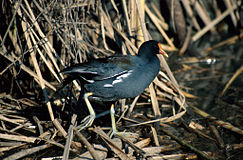
Similar to cerceris, but upperparts coloration more like chloropus. Ranges from Southeast Canada south through the USA, excluding the Great Plains region, to West Panama; also found in the Galápagos and Bermuda. Subandean Common Moorhen
G. c. pauxilla (Bangs, 1915)Similar to cerceris, but smaller. Found in lowland areas of East Panama south to Northwest Peru. Mariana Common Moorhen
G. c. guami (Hartert, 1917)
Called pulattat in Chamorro.Body plumage is very dark. Endemic to the Northern Mariana Islands, but see also G. c. orientalis above.
Population size: About 300 as of 2001.[15]Barbados Moorhen
G. c. barbadensis (Bond, 1954)Similar to cerceris, but with lighter head and neck, and less dull grey overall. Endemic to Barbados. Footnotes
- ^ Chesser et al. (2011)
- ^ a b Lockwood, W B (1993). The Oxford Dictionary of British Bird Names. OUP. ISBN 978-0198661962.
- ^ Jobling, James A (1991). A Dictionary of Scientific Bird Names. OUP. ISBN 0 19 854634 3.
- ^ Snow et al. (1998)
- ^ Mann (1991), Snow et al. (1998)
- ^ Takano & Haig (2004), Hays & Conant (2007)
- ^ a b VanderWerf et al. (2006)
- ^ BLI (2008)
- ^ Dronen et al. (2006)
- ^ Rothschild, Miriam; Clay, Theresa (1953). Fleas, Flukes and Cuckoos. A study of bird parasites. London: Collins. pp. 113. http://ia331318.us.archive.org/1/items/fleasflukescucko017900mbp/fleasflukescucko017900mbp.pdf.
- ^ McCoy (1963), Olson (1974), Louchart et al. (1998)
- ^ a b Wiles et al. (2000, 2004)
- ^ "ʻAlae ʻUla or Hawaiian Moorhen" (PDF). Hawaii’s Comprehensive Wildlife Conservation Strategy. State of Hawaiʻi. 2005-10-01. http://www.state.hi.us/dlnr/dofaw/cwcs/files/NAAT%20final%20CWCS/Chapters/Terrestrial%20Fact%20Sheets/Waterbirds/hawaiian%20moorhen%20NAAT%20final%20!.pdf. Retrieved 2009-03-18.
- ^ Due to uncertainty about the Floridan birds' taxonomic identity, this vernacular name was also applied to ssp. galeata and cachinnans.
- ^ Takano & Haig (2004)
References
- Chesser, R. Terry, Richard C. Banks, F. Keith Barker, Carla Cicero, Jon L. Dunn, Andrew W. Kratter, Irby J. Lovette, Pamela C. Rasmussen, J. V. Remsen, James D. Rising, Douglas F. Stotz, Kevin Winker. 2011. Fifty-second supplement to the American Ornithologists' Union Check-List of North American Birds. Auk 128(3):600-613.
- BirdLife International (BLI) (2008). Gallinula chloropus. In: IUCN 2008. IUCN Red List of Threatened Species. Downloaded on 2 January 2009.
- Dronen, Norman O.; Gardner, Scott L. & Jiménez, F. Agustín (2006): Selfcoelum limnodromi n. gen., n. sp. (Digenea: Cyclocoelidae: Cyclocoelinae) from the long-billed dowitcher, Limnodromus scolopaceus (Charadriiformes: Scolopacidae) from Oklahoma, U.S.A.. Zootaxa 1131: 49–58. PDF fulltext
- Hays, Warren S.T. & Conant, Sheila (2007): Biology and Impacts of Pacific Island Invasive Species. 1. A Worldwide Review of Effects of the Small Indian Mongoose, Herpestes javanicus (Carnivora: Herpestidae). Pac.Sci 61(1): 3-16. DOI:10.2984/1534-6188(2007)61[3:BAIOPI]2.0.CO;2 PDF fulltext
- Louchart, Antoine; Mourer-Chauviré, Cécile; Guleç, Erksin; Howell, Francis Clark & White, Tim D. (1998): L'avifaune de Dursunlu, Turquie, Pléistocène inférieur: climat, environnement et biogéographie [The avfauna of Dursunlu, Turkey, Lower Pleistocene: climate, environment and biogeography]. C. R. Acad. Sci. Paris IIA 327(5): 341-346 [French with English abridged version]. doi:10.1016/S1251-8050(98)80053-0 (HTML abstract)
- Mann, Clive F. (1991): Sunda Frogmouth Batrachostomus cornutus carrying its young. Forktail 6: 77-78. PDF fulltext
- McCoy, John J. (1963): The fossil avifauna of Itchtucknee [sic] River, Florida. Auk 80(3): 335–351. DjVu fulltext PDF fulltext
- Olson, Storrs L. (1974): The Pleistocene Rails of North America. Condor 76(2): 169-175. DjVu fulltext PDF fulltext
- Snow, David W.; Perrins, Christopher M.; Doherty, Paul & Cramp, Stanley (1998): The complete birds of the western Palaearctic on CD-ROM. Oxford University Press. ISBN 0-19-268579-1
- Takano, Leilani L. & Haig, Susan M. (2004): Distribution and Abundance of the Mariana Subspecies of the Common Moorhen. Waterbirds 27(2): 245-250. DOI:10.1675/1524-4695(2004)027[0245:DAAOTM]2.0.CO;2 HTML abstract
- VanderWerf, Eric A.; Wiles, Gary J.; Marshall, Ann P. & Knecht, Melia (2006): Observations of migrants and other birds in Palau, April–May 2005, including the first Micronesian record of a Richard's Pipit. Micronesica 39(1): 11-29. PDF fulltext
- Wiles, Gary J.; Worthington, David J.; Beck, Robert E. Jr.; Pratt, H. Douglas; Aguon, Celestino F. & Pyle, Robert L. (2000): Noteworthy Bird Records for Micronesia, with a Summary of Raptor Sightings in the Mariana Islands, 1988-1999. Micronesica 32(2): 257-284. PDF fulltext
- Wiles, Gary J.; Johnson, Nathan C.; de Cruz, Justine B.; Dutson, Guy; Camacho, Vicente A.; Kepler, Angela Kay; Vice, Daniel S.; Garrett, Kimball L.; Kessler, Curt C. & Pratt, H. Douglas (2004): New and Noteworthy Bird Records for Micronesia, 1986–2003. Micronesica 37(1): 69-96. HTML abstract
External links
- Common Moorhen videos, photos & sounds on the Internet Bird Collection
- Cornell Lab of Ornithology - Common Moorhen
- USGS Patuxent Bird Identification InfoCenter - Common Moorhen Information
- South Dakota Birds and Birding - Common Moorhen Information and Photos
- Madeira Birds - Moorhen breeding in Madeira Island
Categories:- IUCN Red List least concern species
- Gallinula
- Rails
- Birds of Pakistan
- Birds of Puerto Rico
- Birds of Europe
- Birds of Turkey
- Birds of Lithuania
Wikimedia Foundation. 2010.







